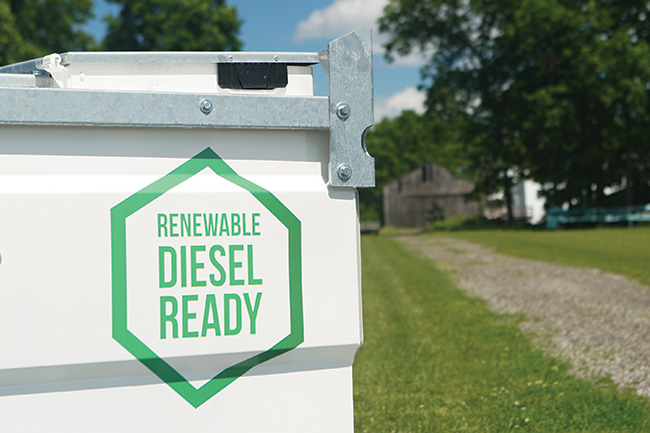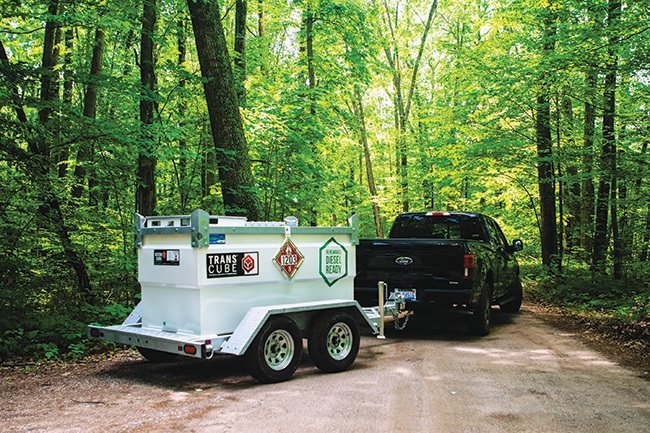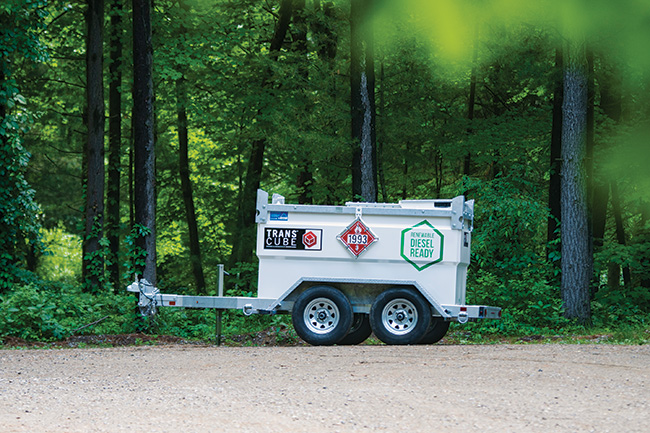How renewable diesel can combine with onsite fuel storage to reduce carbon emissions.
By Jeff Lowe
North America is seeing a growing emphasis on sustainability and the role environmental initiatives play in making the world a cleaner, greener place to live. Both the U.S. and Canada have set targets to reach net-zero emissions by 2050. As states and equipment manufacturers set carbon neutrality and net emissions goals of their own, more fleets and jobsites are striving to meet “green quotas” as they go about their daily work.
It is important to remember that a focus on sustainability means more than environmental benefits; it can also play a direct role in helping operations reduce energy usage, improve efficiency and, as a result, increase profitability. Equipment that can run on battery power and other alternative power sources has gained popularity; however, options that create environmentally friendly solutions for diesel consumption are a critical piece of the puzzle. This is where renewable diesel takes the stage—a new diesel option that is 100 percent sustainable and renewable.

Renewable Diesel 101
Traditionally, diesel—also called petroleum diesel or fossil fuel—is made from crude oil. It has long been a popular fuel for large equipment due to diesel engines’ ability to take on heavy-duty work.
Although petroleum diesel is often favored, it is derived from a non-renewable source of energy and contributes to air pollution. Biodiesel’s introduction created an option to reduce these concerns. However, biodiesel has its limitations. It is not a direct drop-in replacement for diesel and does not perform as well in cold temperatures due to its chemical composition. Now, renewable diesel enters the playing field. With components that maximize the benefits of both biodiesel and petroleum diesel, renewable diesel is setting the standard for the future.
Renewable diesel is a sustainable, low-carbon biofuel derived from waste products and other biomass such as vegetable oils, greases, and natural fats. Like biodiesel, renewable diesel reduces particle
emissions. But unlike biodiesel, renewable diesel is processed by treating oils with hydrogen, which removes the limitations related to reduced shelf life and cold-weather performance that first-generation biodiesel encountered.
The renewable diesel production process involves saturating feedstocks—such as vegetable oils or waste fats—with hydrogen at temperatures above 572°F (300°C). The final step in the process is isomerization, which creates a fuel that is almost chemically identical to petroleum diesel. This means renewable diesel can be used interchangeably with petroleum diesel without requiring additives or special blends.

Storing renewable diesel follows the same guidelines as regular oils like petroleum diesel, kerosene, and other fuel blends. Of course, these fuel storage regulations vary depending on the location and use of the tank, but typically require a UL Listed tank and a form of secondary containment. Onsite fuel storage manufacturers understand these guidelines, and some have created their fuel tanks to be not only UL Listed, but also to include double-walled containment to eliminate the need for a secondary containment pan.
Benefits of Renewable Diesel
Renewable diesel’s ability to serve as a direct drop-in alternative for petroleum diesel is just the start of the advantages this fuel provides. From reduced maintenance and long storage life to its environmental benefits, renewable diesel is a win for everyone involved and excels as an option for all applications where diesel power is required.
Renewable diesel’s clean burning properties reduce particulate production by up to 50 percent, helping to improve air quality. This is a method that contractors can use to meet carbon emission targets for projects while potentially limiting the need to make other changes that might impact jobsite efficiency. This reduced particulate production also helps to improve engine cleanliness and extend the life of the machine.
Additionally, renewable diesel has a higher tolerance to cold temperatures than petroleum diesel. The chemical composition of renewable diesel gives it a freeze point of -40°F (-40°C) while petroleum diesel starts to freeze at around 14°F (-10°C). At the same time, renewable diesel also has a high flash point of 140°F (60°C), which reduces fire hazards.
Unlike first-generation biofuel options, renewable diesel does not contain oxygen, which allows a prolonged storage life of up to 10 years. In comparison, petroleum diesel can only be stored for six to 12 months.
Renewable diesel both improves sustainability and provides efficiency-enhancing benefits. However, before making the switch, check to be sure the equipment OEM has approved the use of the fuel and verify that your fuel storage solution is compatible with renewable diesel.
Storing Fuel for the Future
Using an onsite fuel storage solution can further reduce emissions because the storage tanks can be strategically moved and placed in areas that reduce the distance equipment needs to travel to refuel. It also minimizes the number of deliveries to the site, which means fewer emissions from transport.
For example, if a fleet that consumes 10,000 gallons of fuel per week switches to renewable diesel, they can reduce their emissions by approximately 5,243 metric tons. If that same fleet adds onsite fuel storage along with renewable diesel, they can further reduce their carbon footprint by two additional metric tons per year. This is based on standard MPG calculations for fuel delivery trucks, and reducing weekly site fuel drops from five to one.
Using onsite storage tanks with a fuel management system also allows operations to track fuel usage, which delivers accountability for every drop of fuel. Some onsite fuel tank manufacturers also offer personalized alerts for situations like above-average consumption rates, overfill incidents and more. These customizable reports and alerts are sent as emails or texts and help ensure efficient use of this resource.

Finding a Balance
With the ability to reduce carbon emissions by up to 85 percent, it is no surprise that renewable diesel is viewed by many as the wave of the future. For example, California’s Low Carbon Fuel Standard program aims to decrease carbon intensity and improve air quality. The program’s data dashboard reflects an increase in renewable diesel use in the state, with 2021 marking the year with the highest volume of renewable diesel since the fuel’s introduction to California in 2012.
Although petroleum diesel is still predominant, environmental trends and the benefits that come with this new fuel solution indicate that this is just the start for renewable diesel in North America. Operations can prepare for the future by partnering with manufacturers who offer the flexibility to use either petroleum diesel or renewable diesel for their fleet.
By partnering with an onsite fuel storage solutions provider who is familiar with fuel trends and storage compatibility, operations take further control of their fuel supply. With flexible storage solutions,
operations can be ready to use the best diesel option for their application while reducing emissions during transport and refueling, no matter which type of fuel they choose.
When the time comes, having onsite fuel tanks that are renewable diesel ready will make the switch as seamless as possible so the operation can quickly reap the efficiency and sustainability benefits that renewable diesel provides. | WA
Jeff Lowe is Western Global Americas Director of Products and Sales Enablement. Western Global is a global designer and manufacturer of industry-leading tanks and equipment for fuel storage. Building on a legacy that spans five decades, Western Global offers a wide range of solutions for the safe transportation and storage of fuel. Because every application is unique in its operational storage needs, Western Global engineers industry-specific solutions to ensure success in all of your business endeavors. For more information, visit www.western-global.com or connect on LinkedIn at www.linkedin.com/company/3323016/.
